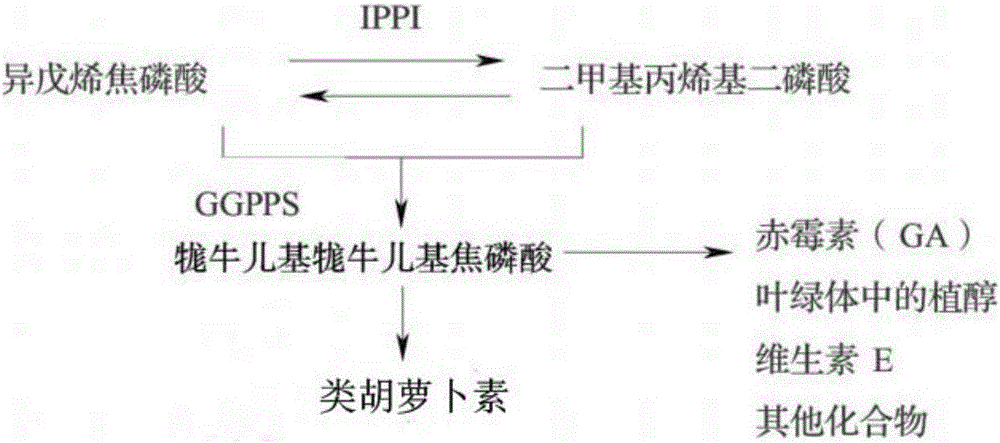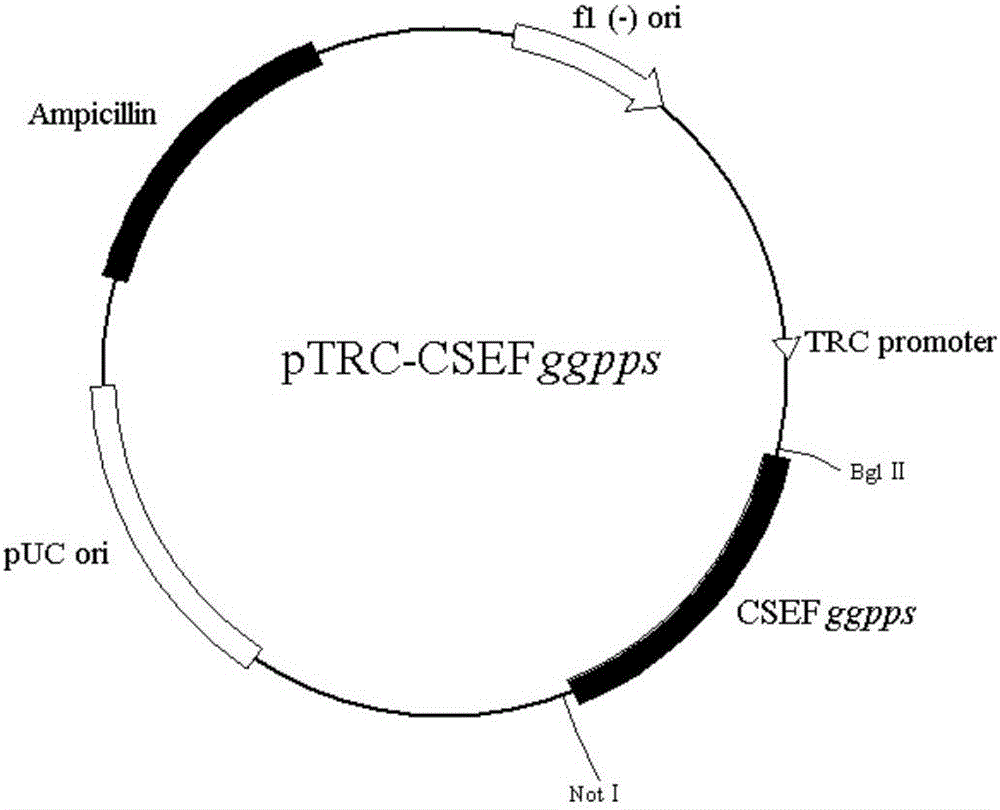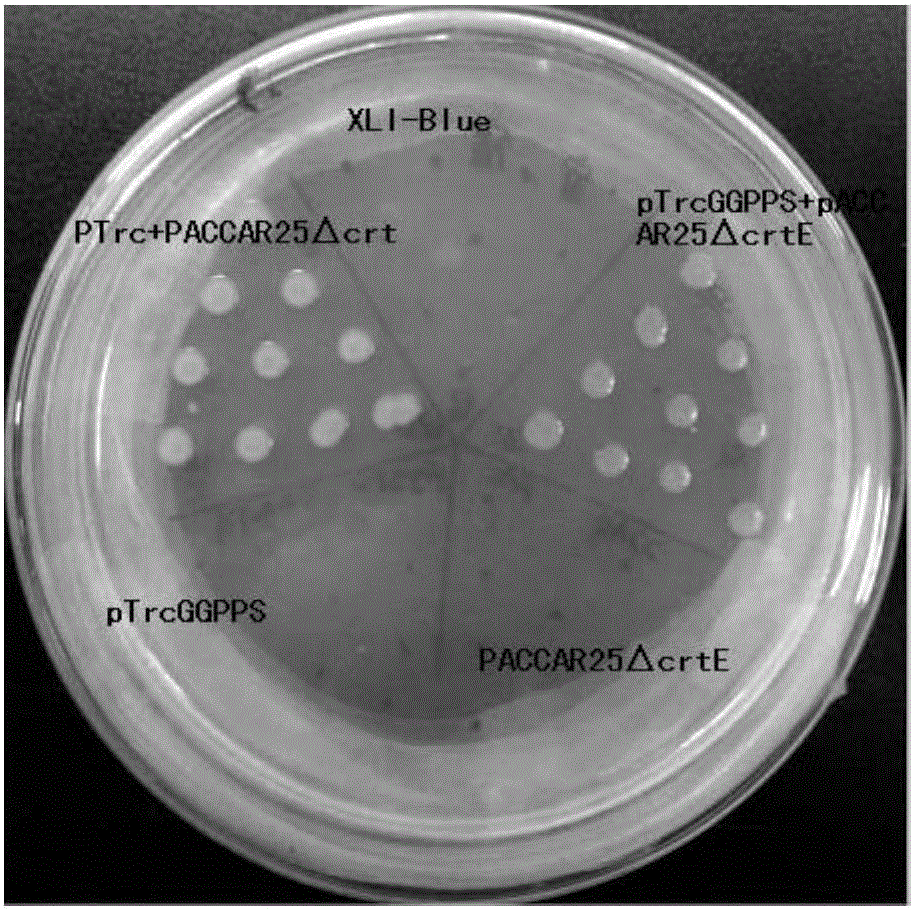Saffron, saffron endophytic fungi GGPPS (geranylgeranyl pyrophosphate synthase) gene, gene cloning method and application
A technology of endophytic fungi and cloning method, which is applied in the field of genetic engineering and can solve the problem of undiscovered function verification.
- Summary
- Abstract
- Description
- Claims
- Application Information
AI Technical Summary
Problems solved by technology
Method used
Image
Examples
Embodiment 1
[0036] The extraction of embodiment 1 saffron endophytic fungus total RNA
[0037] The biological name of the endophytic fungus of saffron is Cadophora luteo-olivacea., and its designated name is 3P1CQ1. It is currently preserved in the General Microbiology Center of China Committee for the Collection of Microbial Cultures. The preservation number is: CGMCCNO.11606, and the preservation date is: 2015 November 24; Preservation address: No. 3, Yard 1, Beichen West Road, Chaoyang District, Beijing. The cultivation and storage conditions of the saffron endophytic fungus are plate storage, and the medium conditions are: 200g of potatoes, 20g of glucose, 5g of potassium dihydrogen phosphate, 1.46g of anhydrous magnesium sulfate, 10mg of VB1, 18g of agar, and single steamed water to 1L.
[0038] Take an appropriate amount of saffron endophytic fungus mycelium and put it into a pre-cooled mortar, pour liquid nitrogen into it, grind it quickly to powder, add 1ml RNAiso Plus, and follo...
Embodiment 2
[0039] Example 2 Cloning of the GGPPS Conserved Fragment of the Endophytic Fungus Saffron
[0040] Genomic DNA of endophytic fungus mycelium of saffron was extracted by CTAB method as a template, and primers Fg1: 5'-AAATCAGTTCTGCGACCTGTTCC-3' and Rg1: 5'-CGGTCTTGTTTCCAACCATTTC-3' were used to design primers in conserved regions for PCR amplification. The reaction system is as follows: Template 1 μL, primers Fg1 (20 μM) and Rg1 (20 μM) each 0.5 μL, TakaraPremix Taq 25 μL, ddH 2 O 22 μL, the PCR amplified band was recovered by gel, ligated and transformed into DH5α competent cells, and then sent for sequencing to obtain the GGPPS conserved fragment sequence.
Embodiment 3
[0041] Example 3 Cloning of the 3' end of the GGPPS gene of the saffron endophyte
[0042] The 3′RACE (rapid-amplification of cDNA ends, RACE) specific primer GSP2 was designed according to the GGPPS conserved fragment sequence: 5′–CGACCTGTTC CAGAGGGCG ATTG–3′. Then, 3'-RACE cDNA and 5'-RACE cDNA were synthesized by reverse transcription using the protocol provided by SMART RACE cDNA Amplification Kit (CLONTECH, USA). 3′-RACE PCR reaction system: Template (3′-RACE cDNA) 4 μL, primer Long UP (4 μM) 1 μL, primer Short UP (20 μM) 1 μL, primer GSP2 (20 μM) 1 μL, 10×Buffer 5 μL, dNTP (2.5 mM each) 4 μL, Taq DNA polymerase 25 μL, ddH 2 O 9 μL, PCR amplification conditions: pre-denaturation at 94°C for 5 min; denaturation at 94°C for 30 s, extension at 72°C for 3 min, 5 cycles; denaturation at 94°C for 30 s, annealing at 70°C for 30 s, extension at 72°C for 2 min, 5 cycles; denaturation at 94°C 30s, annealing at 68°C for 30s, extension at 72°C for 2min, 25 cycles; finally extension...
PUM
 Login to View More
Login to View More Abstract
Description
Claims
Application Information
 Login to View More
Login to View More - R&D
- Intellectual Property
- Life Sciences
- Materials
- Tech Scout
- Unparalleled Data Quality
- Higher Quality Content
- 60% Fewer Hallucinations
Browse by: Latest US Patents, China's latest patents, Technical Efficacy Thesaurus, Application Domain, Technology Topic, Popular Technical Reports.
© 2025 PatSnap. All rights reserved.Legal|Privacy policy|Modern Slavery Act Transparency Statement|Sitemap|About US| Contact US: help@patsnap.com



